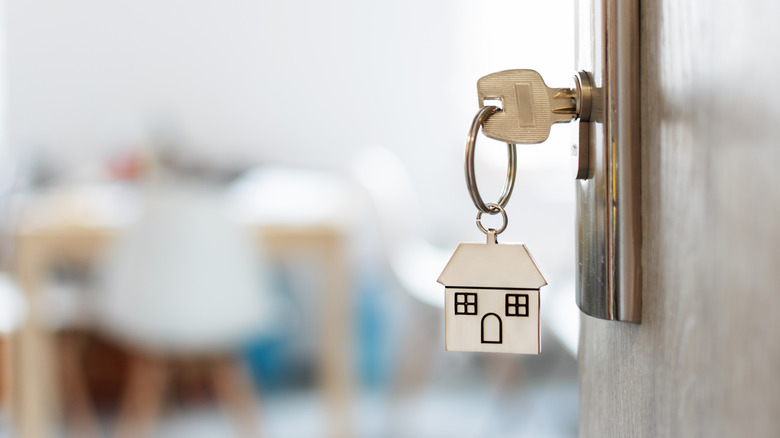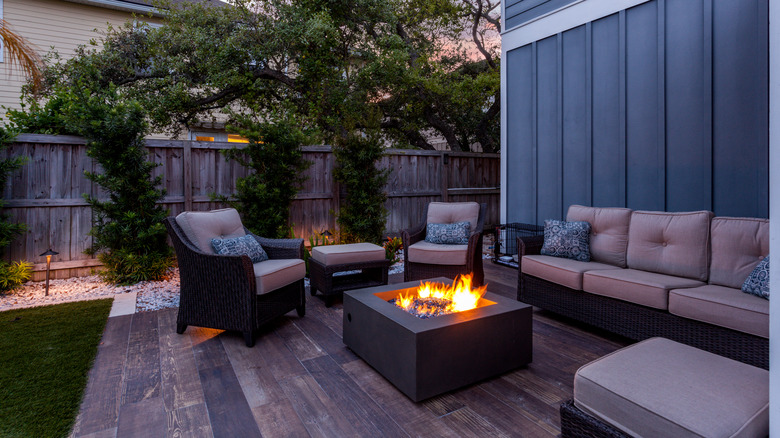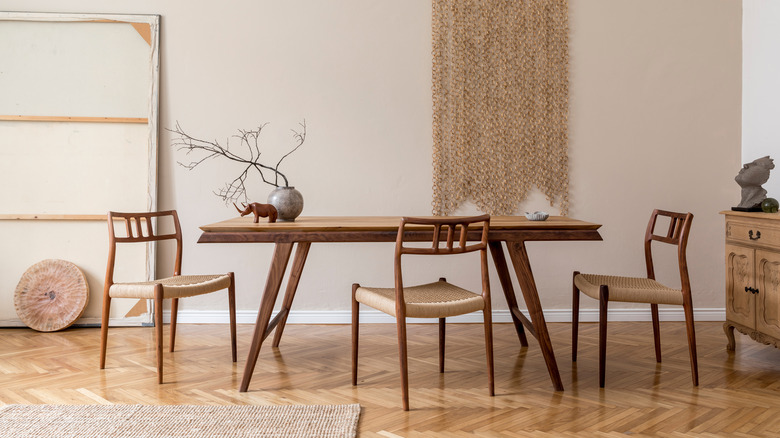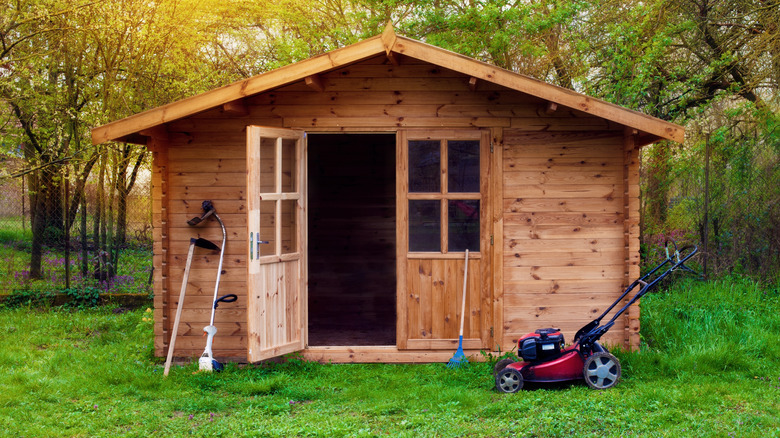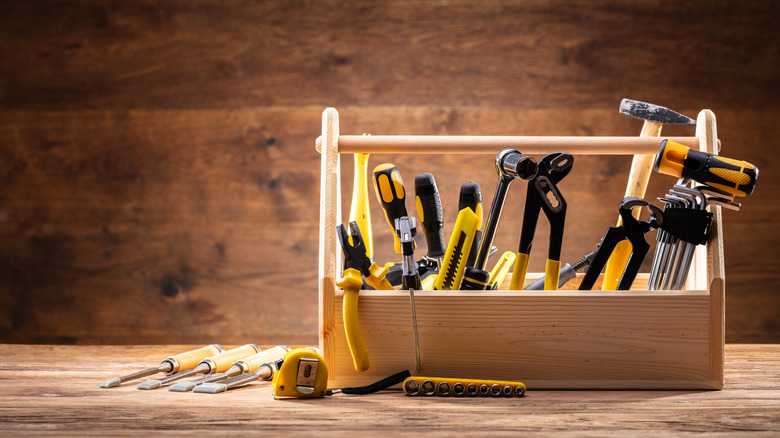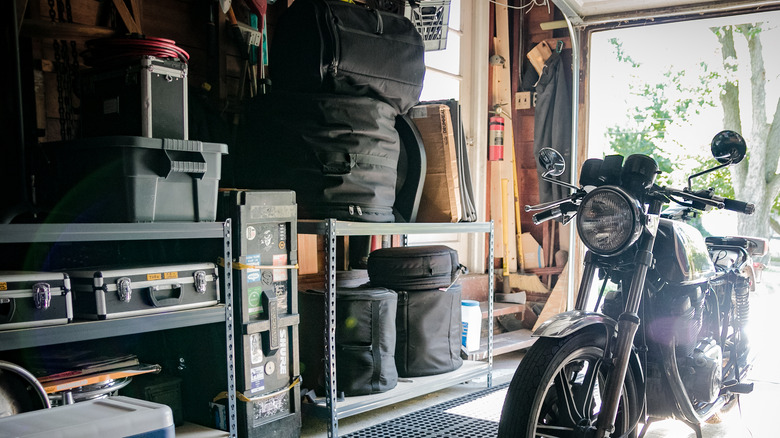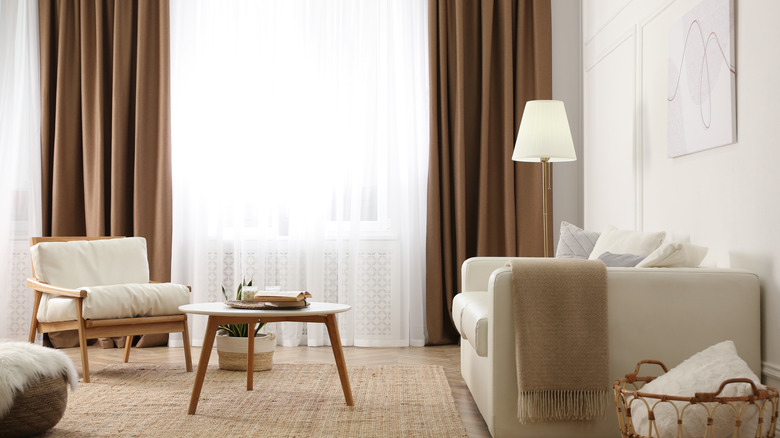What You Need To Buy When Transitioning From An Apartment To A House
While every property has its own unique quirks and features you may have to work around, from an awkwardly-located kitchen island to a space with precious few electrical outlets for all your chargers, there's definitely something particularly challenging about transitioning from an apartment to a house. Now, there are certainly plenty of apartments that have multiple bedrooms and even more square footage than a cozy little house might. However, for many adults, the transition involves moving from a studio or one-bedroom apartment (or perhaps a larger shared space with multiple roommates) to a house that's all your own. While a lot of your furniture and belongings will just need to find a new spot in your new house, there are a few things that you may need to add to your shopping list that you never thought twice about while living in an apartment, per Millennial Homeowner. It'll likely be a learning process in which you find out you're missing a crucial piece of furniture or tool right when you need to use it, but that's why preparing in advance is key.
So, if you're making the move from a smaller apartment with a landlord to fix all your woes to a larger house in which you're responsible for hosting any friends and for repairing anything that goes awry, here are a few things you may want to add to your shopping list in order to make the transition as smooth as possible.
Outdoor furniture is a must-have
Perhaps you were blessed to have an absolutely incredible, super-sized balcony at your apartment — if so, you might be all set. However, a larger outdoor space is one of the biggest reasons that many people opt to move into a house, so they can enjoy all the perks that a backyard has to offer, says Family Handyman. Not only is a great backyard the perfect spot for kids to play or to have a few friends over after a long week, it also gives you even more living space. To take advantage of that space, though, you may need to pick up a few items.
If your apartment had room for only one or two small chairs with a tiny bistro-style table, this is the time to invest in a larger outdoor dining set. They can be a bit on the pricier side, but it'll become a great gathering place for your guests as you toss a few burgers on the grill and bring out a few drinks. A patio umbrella can be beneficial in making that outdoor dining area perfect for all times of day, even the sunniest afternoon periods, and can provide cover if you get stuck in the rain.
In addition to patio furniture, you may want a seating area where you can relax and enjoy the beauty of your backyard. If you really want to level up your outdoor space, consider a few decorative accents, like outdoor lights, as well.
You may need a bigger dining room set
Again, unless you're transitioning from a super-sized apartment with some serious square footage, there's a good chance that your "dining room" was basically just the coffee table and couch in your living room. Perhaps you had an eat-in counter or a tiny spot where you could squeeze in seating for two, but in general, apartments aren't the best spots to have massive dining room tables. Now that you're transitioning into a house, however, you may just have the option to carve out a bit more space for dining. Hence, you may want to invest in a dining room set.
You will need to consider the amount of space you have — there's no sense squeezing in a table that seats 12 if people can't even pull their chairs out. However, if you foresee hosting quite a few dinner parties in the future, or relish the idea of your home being the gathering spot for family and friends during the holiday season, you may want to consider selecting a larger table that could seat a few extra people. Just make sure to leave about 42 to 46 inches from the edge of the table to the wall, in order to ensure your guests have enough space to navigate around the room, suggests Germain LaRiviere. And, depending on the space, you could consider whether you want to go with a rectangular table or a circular option — both have their pros and cons.
Outdoor maintenance equipment is essential
So you've already invested in an outdoor dining set and a few seats to arrange around your fire pit, as well as an upgraded BBQ and some charming patio lights you've strung across the yard. However, there's one more important category of purchase to add to your list when you transition from an apartment to a house: outdoor maintenance equipment, according to Worx. What you'll actually need will depend on the climate where you live. No matter what, you'll probably want at least a lawn mower in order to keep your lawn looking good during the warmer months. In order to ensure your lawn stays lush and green, and that any plants you decide to add are also properly hydrated, you'll also want a garden hose as well as any attachments you may require for it. Depending on the level of green thumb you have and what type of plants are already found on your property, you may also need to buy a hedge trimmer, pruner, rake, shovel, or other garden tools.
Additionally, if you live in a cold-weather climate, you'll need to take care of the snow that will fall. Invest in at least one good snow shovel (perhaps two, if you have a partner who you can get to assist you in the shoveling process), and if you have a particularly large stretch of sidewalk or driveway, you might even want to spring for a snowblower to make your life a little easier.
Don't forget to buy tools for small repairs
If you're moving from an apartment you own into a house you own, you may have a small collection of tools you've purchased over the years. However, if you're transitioning from an apartment where the landlord is responsible for everything from a clogged sink to a malfunctioning radiator, well — the bad news is, that's all on your shoulders now that you're a homeowner. Sure, you could hire someone to repair every little thing, but sometimes all it takes is a trip to the hardware store and a few YouTube tutorials in order to figure out how to patch up those nail holes in the wall or to take apart your sink so you can remove a pesky clog.
You don't need to break the bank getting every type of tool under the sun, but you will probably want to equip yourself with a few standard options such as a screwdriver set, a stud finder, a hammer, a flashlight, a level, a tape measure, and perhaps a small step ladder for reaching certain higher areas, per Millennial Homeowner. You may need to get a few additional items when faced with certain repairs, but for the most part, having a collection of the basics should help get you through typical things like putting together furniture or hanging pictures.
More space means more storage solutions
One of the biggest perks of transitioning from an apartment to a house is generally the increase in square footage you have to work with. Whether you've opted for a two-story property or a bungalow, chances are you'll have a whole lot more closets as well as potentially a basement and garage for even more storage solutions. Sure, you could just toss all your extra junk into a closet and hope you never have to open the doors again, or you could resign yourself to a multi-hour expedition every time you need to track something down in your cluttered basement. However, if you're already starting fresh as you move into the space, why not invest in a few storage solutions? You don't need to go full-on The Home Edit, rainbow-color-coding every item in every drawer, but a few key pieces can really help out, notes The Plan Collection.
If you're looking to keep a lot of seasonal equipment and sports gear in your garage or basement, invest in some shelving units that will help organize the space. For things like linen closets, pantries and cabinets, you may want to purchase a few organizers or containers in order to streamline the space and make it really work for you. You don't need to spend an arm and a leg, but a few smart investments can help keep clutter at bay and allow you to make the most of the new space in your home.
Textiles can make a house a home
Often, after splurging on a few key pieces of furniture that you didn't have room for in your apartment, and stocking up your tool box and garage with all the equipment you need to ensure your house looks its best year round, the last thing you want to do is spend even more money on things like textiles. However, don't be tempted to cut corners here — textiles really can transform a space and make a house feel like a home, as noted by The Modern House.
First of all, you'll likely have more windows in an entire house than you did in your apartment, so you'll likely need to buy a few more sets of curtains, or blinds if they're your window covering of choice. In some spots, you may even want to invest in two sets of curtains — a blackout or darkening layer for the evening, and a semi-sheer set that lets in some light during the daytime (via Blinds).
Then, unless your space happens to have wall-to-wall carpeting, you may want to buy a few area rugs in order to add some personality, as well as some warmth and coziness to your house. Finally, if you find yourself too tired from the whole moving process to handle any painting projects right at the beginning, a great way to introduce a few pops of color is through textiles like throw pillows and blankets.
